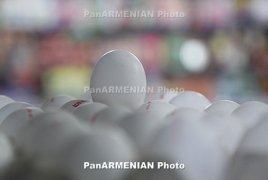Scientists use eggs to produce clean energy February 16, 2018 - 18:35 AMT PanARMENIAN.Net - Scientists in Japan have developed a new way to produce clean energy from eggs, Public Reporter says. The work by researchers at the Osaka City University in Japan has been published in Applied Catalysis B. The work involves use of egg whites as a substrate to produce a carbon-free fuel. The latest research is the result of the need for development of method to produce hydrogen without the need of fossil fuels. Researchers say it would be extremely efficient to use a photocatalyst to speed the reaction of hydrogen generation from a renewable source, such as solar power. This particular method is called hydrogen evolution wherein the gas must be stored and kept from recombining into more common molecules that aren’t useful for producing clean fuel. However, precise accumulation of molecules acting as catalytic components are important to construct a photocatalytic system and as per scientists the catalytic reactions cannot proceed if the molecular components are randomly distributed in the solution or formless compounds. One of the ways is to precisely accumulate these catalytic molecules is through the production of pure proteins by cultivated bacteria; however, that would require specialized lab equipment and the whole thing would turn out to be cost ineffective. This is where eggs – egg white specifically – come into play as they are not only inexpensive, but inexhaustible as well and they come with porous lysozyme crystals. “Lysozyme crystals have a highly ordered nanostructure and, thus, we can manipulate the molecular components when they accumulate in the crystals,” scientists say, noting that the crystal structure can be easily analyzed with X-ray technology. This analysis is of particular importance because the molecular components within the crystals must be manipulated precisely through what is called cooperative immobilization. This is achieved by the application of rose bengal, which is commonly used as a dye in eye drops to identify damage. In this case, it entered the solvent channels in the lysozyme crystals and accelerated the hydrogen evolution reaction, since the functional molecules and nanoparticles can be accumulated within the crystals’ inner spaces. “These results suggest that porous protein crystals are promising platforms to periodically and rationally accumulate catalytic components by using molecular interactions,” scientists add. Photo. SmittenKitchen.com Authorities said a total of 192 Azerbaijani troops were killed and 511 were wounded during Azerbaijan’s offensive. In 2023, the Azerbaijani government will increase the country’s defense budget by more than 1.1 billion manats ($650 million). The bill, published on Monday, is designed to "eliminate the shortcomings of an unreasonably broad interpretation of the key concept of "compatriot". The earthquake caused a temporary blackout, damaged many buildings and closed a number of rural roads. Partner news |